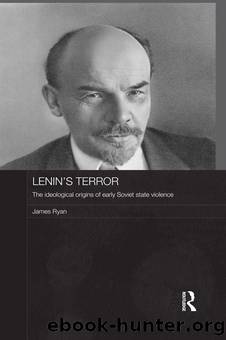Lenin's Terror by James Ryan

Author:James Ryan [Ryan, James]
Language: eng
Format: epub
Tags: Social Science, Ethnic Studies, General
ISBN: 9780415673969
Google: xxGttzFXqaYC
Publisher: Routledge
Published: 2012-01-15T02:37:39+00:00
Civil War, phase three: springâwinter 1919
If the first phase of the Civil War began in winter 1917â18, and the second phase began on the Volga with the Czech Legion and Komuch, then the third phase began with Kolchakâs offensive launched from Ufa in March 1919. This was soon followed by Denikinâs push for Moscow from the South and the threat to Petrograd from General Iudenich. Thus began the main phase of the âRed versus Whiteâ Civil War, pitting the Reds against the forces opposed to socialism: an umbrella of conservatives, monarchists, liberals, landowners, Tsarist army officers and generals etc., supported by Western allied and Japanese forces.
It is worth analysing in some detail Leninâs rhetoric in spring 1919. Referring to the fact that some Mensheviks, in defiance of their Central Committee, were actively supporting anti-Bolshevik forces, he acknowledged that âWe, of course, persecute Mensheviks, even shoot them, when they wage war against us, fight our Red Army and shoot our Red commandersâ.73 Responding to the spread of peasant revolts, he once again labelled these âkulakâ revolts and justified their suppression, for âThe kulak is our implacable enemy.â The middle peasant, however, âis a different case, he is not our enemy.â The peasant revolts in fact involved entire villages but in public Lenin was largely incredulous, declaring that: âAn individual village or volost does join the kulaks, but under Soviet power there have been no peasant revolts that involved all the peasants in Russia.â74 On 14 March the Central Committee agreed to strengthen the Vechekaâs forces in direct response to the peasant uprisings, which it described as âundoubtedly led by the Left and Right SRsâ, by recalling its most âreliable workersâ who had been transferred to other posts,75 presumably to better enable the Chekas to win the âhearts and mindsâ of poor and middle peasants. There was a distinct contrast in Leninâs thought between the ideal of neutralizing the middle peasant and the perceived practical necessity of resorting to force to suppress risings; as Bertrand Patenaude notes, âThe element of coercion directed against the entire peasantry was to become the hallmark of the razverstka.â76 Lenin did emphasize, though, that the requisition quotas were to be relaxed for the middle peasants.77
One of the principal reasons for the peasant revolts in 1919 was conscription to the Red Army and the consequent rise in desertion and formation of groups of deserter-âbanditsâ.78 It is arguable that a more compact but better trained and supplied army rather than the mass conscript army of workers and (mainly) peasants would have resulted in a more effective force, and would have reduced state-peasant conflict. In a speech in May Lenin addressed the dissatisfaction of the narod that the Bolsheviks had not kept their promise to deliver peace having presented themselves in 1917 as the only party that could secure it. The Bolsheviks, he explained, had found that âthe whole civilized worldâ was attacking weak and ruined Russia. He also unapologetically acknowledged in eschatological terms Bolshevik dual responsibility for the Civil
Download
This site does not store any files on its server. We only index and link to content provided by other sites. Please contact the content providers to delete copyright contents if any and email us, we'll remove relevant links or contents immediately.
Chaco's Northern Prodigies : Salmon, Aztec, and the Ascendancy of the Middle San Juan Region after AD 1100 by Paul F. Reed(355)
Law Enforcement Interpersonal Communication and Conflict Management by Brian Douglas Fitch(348)
Digital International Relations by Unknown(347)
Critical Perspectives on Human Security : Rethinking Emancipation and Power in International Relations by David Chandler; Nik Hynek(329)
Skilled interpersonal communication: Research, theory and practice, Fifth edition by Owen Hargie(328)
The Enduring Color Line in U.S. Athletics by Krystal Beamon Chris M. Messer(325)
Evidence-Based Policy Making in Labor Economics by Hamermesh Daniel S.;Nottmeyer Olga K.;Nottmeyer Olga;King Sarah;King Sarah;King Sarah;(298)
EPSO CAST Political affairs EU policies: How to succeed in the selection procedure by Franco Reverte José María(292)
Writing Public Policy - A Practical Guide to Communicating in the Policy Making Process by Catherine F. Smith(272)
Criminological Theory in Context by John Martyn Chamberlain(270)
Tibeton Yoga Its Secret Doc by Evans-Wentz(267)
Rothschild and Early Jewish Colonization in Palestine (Geographical Perspectives on the Human Past) by Ran Aaronsohn(266)
Threshold Concepts in Women's and Gender Studies by Christie Launius Holly Hassel(265)
Positive Psychology and Spirituality in Counselling and Psychotherapy (Conflict, Ethics, and Spirituality, 12) by unknow(261)
Social Problems, Social Issues, Social Science by James Wright(260)
Play in child development and psychotherapy: toward empirically supported practice by Sandra W. Russ(254)
Cognitive Development in Infancy and Childhood (Elements in Child Development) by Mary Gauvain(253)
Latin American Politics and Society by Gerardo L. Munck & Juan Pablo Luna(224)
What Makes a Social Crisis?: The Societalization of Social Problems by Jeffrey C. Alexander(220)
